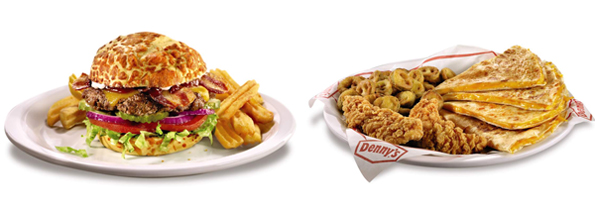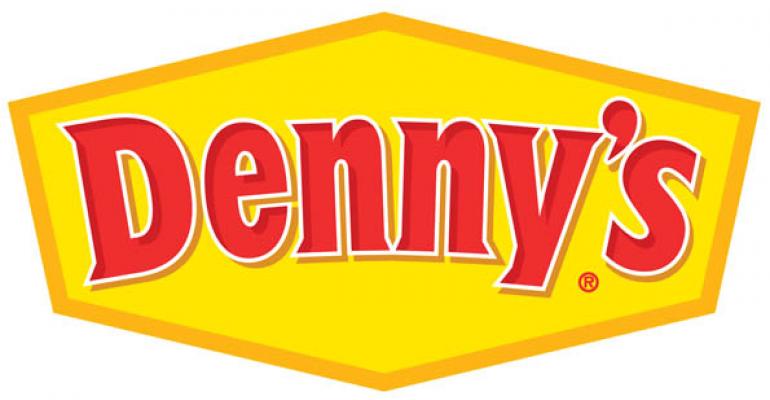After posting a nearly 35-percent increase in profit during the second quarter, Denny’s Corp. president and chief executive John Miller is optimistic about the family-dining operator’s future.
Although the Spartanburg, S.C.-based company has experienced flat same-store sales growth for several quarters running, its core initiatives — including adding lunch and dinner items to the menu, and a new coffee platform — are starting to gain traction with consumers.
“We have confidence in our initiatives — consumers are responding to them — but where employment has been lagging, so have been our sales,” he said of the earnings report. “We’re more likely to say we’re disappointed. We’re happy with our initiatives, but we’d always like to see sales break out a little stronger.”
MULTIMEDIA
Denny's CEO talks coffee, value
RELATED
• Denny's looks beyond breakfast with new menu items
• Denny's 2Q profit rises nearly 35%
• More family-dining restaurant news
Miller discussed the 1,700-unit chain’s performance, and its future, with Nation’s Restaurant News last week in New York.
Denny’s released its second-quarter earnings last week. What do you think about the company’s performance?
There’s two sides of it. One is that we’re 90-percent franchised, so it’s very stable. We have really good high-quality free cash flows. With that comes a need to build our top lines.
Family [Dining] still has the more robust side of full-service sales. There was a good showing for family during the second quarter, with the stronger performers for the quarter being Denny’s and IHOP.
Why did family dining perform relatively well in the quarter versus casual-dining brands?
The value orientation. At the end of the day, the average check is $9 [at Denny’s] instead of $14. There’s maybe something there.
What matters most is when you come back, that when a customer comes in they intend to return. The most sacred thing about running a restaurant company is that the customer comes back.
The pressure on the table also matters. We’ve uncovered some consumers that say one of the attractions to family dining is that even if we’re busy and we’re on a wait, there’s less pressure to make you leave than in the casual business. If it’s Saturday morning and you’re waiting 30 minutes for your table, you’re not real worried about having that extra cup of coffee.

During the second-quarter earnings call with analysts, you said Denny’s will expand its beyond-breakfast menu items. Why?
This was borne out of, first and foremost, this broadening strategy to transform from this breakfast-all-day-only strategy. We talked really only about our breakfast items for the better part of 20 years. And when times were tough you go to a Grand Slam promotion and all was well with the world.
Today we believe that that’s important, to hold onto breakfast share. We’re not above a pancake promotion — we have a build-your-own-pancake promotion running right now. But this beyond-breakfast strategy, this 'America's Diner' idea, was a little bit bigger, a little broader, to have a little more relevance for lunch and dinner. That started a little while back, first with the research on the broadening positioning.
Dinner had been a part of our heritage as a diner. To be able to go back to that, sort of evolve backwards to be forward, is the idea behind [beyond breakfast].
Many new menu items, including the wild rice side, seem to have healthful cues as well as premium cues. Was that the goal?
That actually fits into our Fit Fare Menu. Our Fit Fare menu has grown from four introductory offers two years ago. We now have 12 items on the Fit Fare menu. And we cover lean, high protein, low calorie and high fiber, all with icons marking them throughout the menu. The new ones are lower in mix until they catch on, but the older ones that we’ve had a while are doing great. They’ve doubled since we put them on.
The top seller is the Fit Fare Omelette followed closely by the Fit Slam. The Senior Slam is next, and then the avocado turkey sandwich.
Historically, [when] you’d see Fit Fare items, or whatever these are called, on other peoples’ menus, you’d see less than 1 percent of menu mix. At Denny’s they add up to a significant number of items per day.
Implementing new menu items
(Continued from page 1)
Describe the premium menu items Denny’s has added.
We always did a great omelette. Moons Over My Hammy is the one everybody talks about, but actually the prime rib Philly Cheesesteak Omelette is a top seller. It’s premium. It’s a $9 omelette. It has prime rib grilled like a Philly cheese steak, but thicker. It has Swiss cheese and grilled peppers, mushrooms and onions. It takes a little more sauté skill, but it is a fantastic omelette.
It’s one of those things where people come in and go, ‘I meant to spend $6.50 for a Grand Slam, but that Philly Cheesesteak Omelette is so good.’ Stretching the premium side of the menu is catching on for us. Getting the culinary credibility to do the work, and then to see the repeat visits on it. We’re real proud of it.
Is it difficult to add new skills, like sautéing, to the line cooks’ repertoire?
It is, but if you prep properly it’s not. It’s getting familiar with a good short-order cook. But there are tradeoffs. If it is a daypart when you’re not especially busy, and you’re not prepared for it, you’re not going to add a cook until you’re certain that business is going to come.

How you prep and prepare for these broadening strategies is critically important. Training has to be done right, and you have to take some things off the menu that are a distraction and are in the way.
We pulled some things off the menu that didn’t matter. Let the bar and grill guys have the wings; they’re gone from Denny’s now. We had a very good one, but it’s not as important as that top cut sirloin.
Denny's added a new coffee platform earlier this year. How is it performing?
Our new platform is doing really well. There are people who really want a bold coffee and they aren’t going to be satisfied with the light, and then you have people who like the light who are scared away by the bold. So we had to have both. We also upgraded our decaf.
Then we added the iced coffee module. We’re selling 50 to 60 of those a week on top of the extra 40 cups of coffee. We’ll build on that with each successive module. We’ll have some sort of iced coffee certainly during the summers and into the holidays, something like that.
Operationally, how hard was it to switch the coffee program systemwide?
It’s tremendously difficult because you’re asking a server to carry two pots or to make two trips. You’re asking the owner to make some coffee he’ll throw out, or make the customer wait until you brew it. It’s not easy to get a whole system to say that’s a great idea. But the customer is saying [they want it], especially if they’re a coffee-first decision maker. The number of people who make a coffee-first decision is growing.
Contact Erin Dostal at [email protected].
Follow her on Twitter: @ErinDostal

